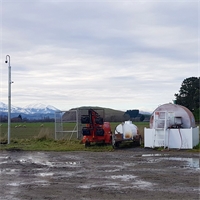29Nov
Agri-Chemical Update Summer 2022
Words by Bill Cabout, Ruralco Ashburton Store Manager
For the next three months we are looking at the final sprays for finishing off our cereal and grass seed crops, getting our silos cleaned up before harvest, continuing our post emergence sprays on fodder beet, pre and post emergence sprays on forage brassicas and weed control in new pasture.
Cereals
Over the next few weeks, we are looking at putting on the final fungicide sprays to maintain disease free crops through to harvest.
Wheat - T2 Growth Stage 39.
Flag leaf fungicide spray can be applied; due to the possible disease pressure from the mixed weather we are having, we should be applying a SDHI fungicide in conjunction with a triazole to protect the flag leaf as a lot of potential yield comes at this time. Follow this at full ear emergence (GS61) with a triazole + strobilurin fungicide to ensure protection from leaf rust.
Barley - T1 Growth stage 31-32.
A lot of spring sown crops will be at or coming up to this stage. A fungicide spray of a triazole + strobilurin fungicide should be applied now. Autumn sown crops will be coming up to T2 (growth stage 39) at this time and because of the disease pressure from the mixed weather we are having a SDHI and Triazole fungicide should be applied. Follow this at full ear emergence (GS61) with a triazole + strobilurin fungicide.
Grass seed
The main fungicide application timings in perennial ryegrass for stem rust control are based on the implementation of a preventative fungicide programme. The first application must be made prior to disease being visually present in the crop, thus the common preventative timings are at PGR application, ear emergence and at flowering with this application including a fungicide to control blind seed disease.
For all fungicide applications, consider the negative effects of fungicides on some novel endophytes, consult your company representative and be aware of the withholding periods following fungicide application in relation to straw being sold from ryegrass seed crops.
Silo Clean Up
This is the time to get those empty silos ready to accept the new seasons harvest. Silo hygiene is a key element in controlling stored grain pests. Key steps are:
- Remove grain residues from empty silos and grain handling equipment, to ensure an uncontaminated start for new-season grain.
- Clean up around silos, removing weeds and rubbish. Mow around the storage facility and ensure easy access to the storage facility. This area can be sprayed with an insecticide to control any overwintering pests.
- When you have completely emptied and cleaned out your silo, we recommend you spray them and all grain handling equipment with an applicable insecticide.
- Once you have cleaned and sprayed out your silos, we suggest you fumigate them out with smoke generators. These are used at one smoke generator per 333 cubic metres (250 t of wheat).
Grain going into the cleaned and fumigated silo should be treated with either insecticide dust or liquid to control pests during storage.
Fodder Beet
Most crops have had their 1st post emergence sprays of both herbicides and insecticides. Over the next few weeks, the 2nd post emergence herbicide spray will be applied as well as herbicide sprays to control grass weeds and thistles. To control grass weeds in fodder beet, we have two main products.
- Sequence from Nufarm has a registration for fodder beet with a withholding period of 63 days before grazing.
- Gallant is now registered for use in fodder beet crops as well but remember it has a withholding period before grazing of 14 weeks (98 days) plus other conditions.
Make sure you read the label before applying. Gallant can also be used to control storksbill. Regular insecticides sprays are needed to control aphids. A fungicide can also be applied. These should be applied at first sign of disease with a maximum of 2 sprays per season. Remember to check the withholding period of any products used when starting to graze your crops with fungicides such as Escolta having a 42-day withholding period before grazing or Custodia having a 28-day withholding period.
Forage Brassicas
After planting, a pre-emergence spray is normally applied for weed control. Regular insecticide sprays are also needed to control insect pests. Normally a post emergence weed spray is required. Be careful what is used at this stage, as the chemical used here can affect what can be grown next year. This year we have a product from Corteva for controlling weeds in Fodder Brassicas called Milestone. This covers a good range of weeds. They also have Korvetto. This product has short plant-back periods, excellent crop safety and kills a good range of weeds but needs to be applied when weeds are small.
Forage Brassicas are an ideal crop to use IPM (Integrated Pest Management) in. IPM refers to the use of cultural and biological controls as well as selective chemical insecticides that can be used to effectively control pests in crops. Selective insecticides include Transform, Pirimor, Sparta and Exirel. These products only target the pests leaving the beneficial insects such as hover flies, lacewings, ladybirds and others to go about their business of controlling the pests.
New Pastures
It is a good idea to be proactive in controlling weeds in new pastures as what you do at this stage can affect the amount of grass produced as well as the longevity of the pasture. There are several different options available depending on your weed spectrum.
With all the above scenarios, talk to your Ruralco representative for the best options for you and your situation.
Related

Aching joints, sore back, uneasy sleep and recurring irritability may all seem unrelated, but in fac...
Read More

There’s even more cause for celebration at this year’s Ruralco Instore Days as the farming co-oper...
Read More

History said she was just a man’s muse. History was wrong. The exquisite new novel from bestselling...
Read More

Over the past couple of years around the world “green” energy options have become very much the ma...
Read More

Ensuring your bulk fuel storage is fit for purpose is not just about compliance. It is also about ha...
Read More

With registrations now open for the 2023 Ruralco Longbeach Coastal Challenge the organising committe...
Read More